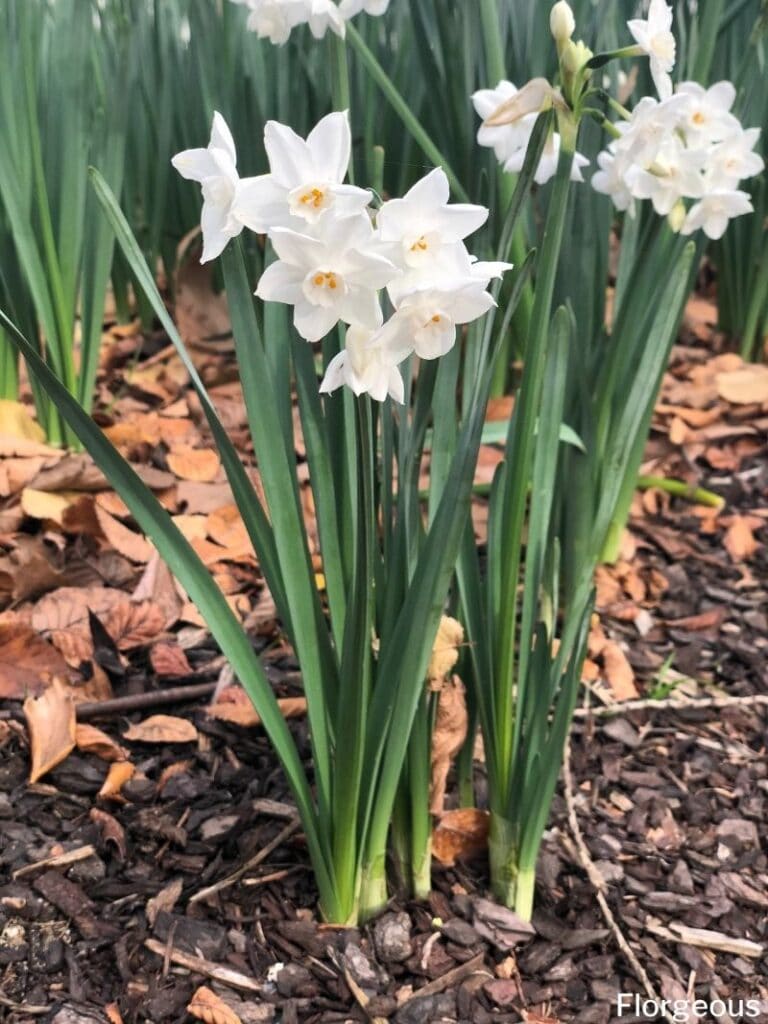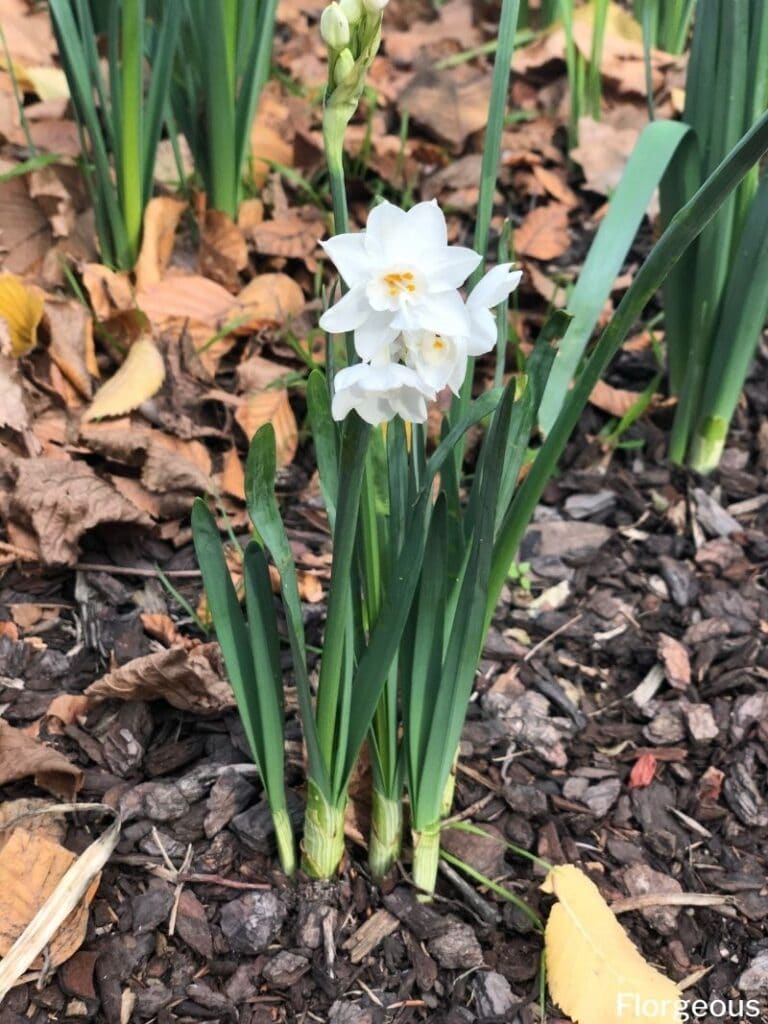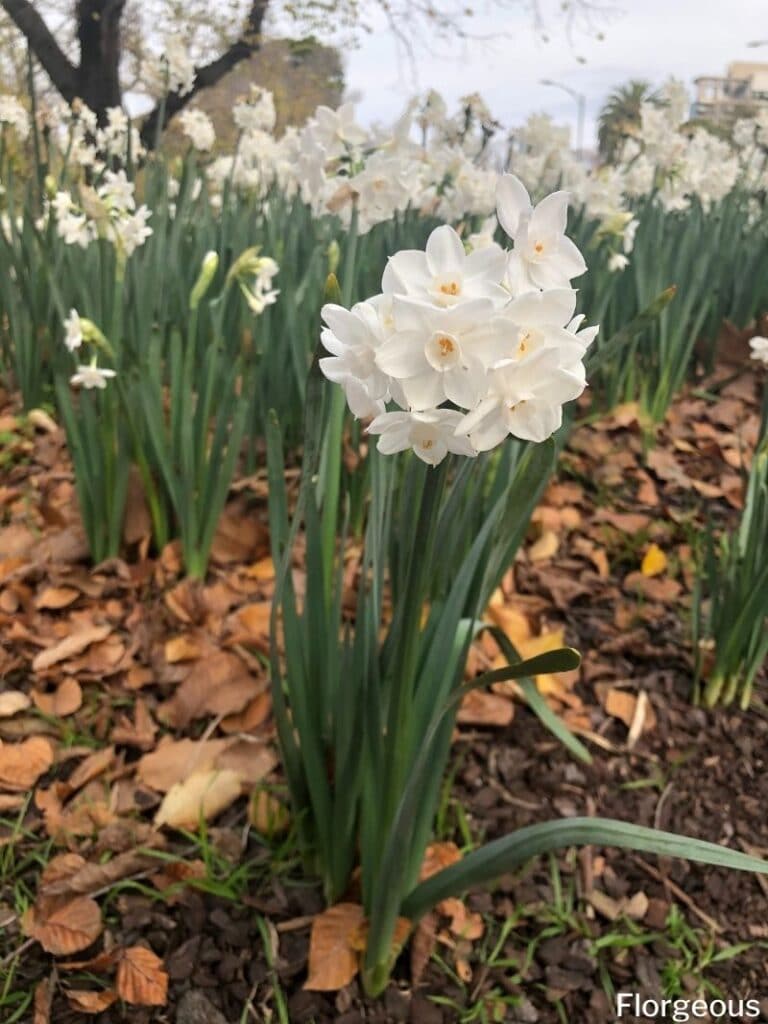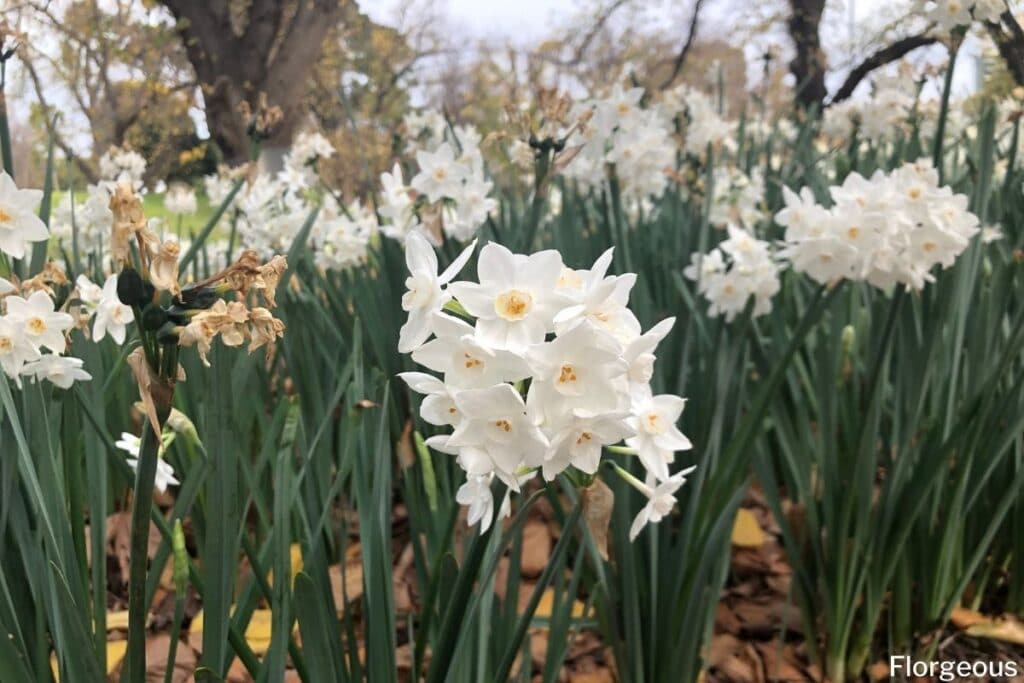You may have heard the narcissus flower referred to by names such as daffodil, jonquil, or other phrases.
That’s because, technically, the word “narcissus” refers to an entire genus of spring-flowering perennial plants in the amaryllis family. The paperwhite narcissus flower, or Narcissus papyraceus, is a plant within that genus, and it’s known for making a powerful impact in the garden.
In this article, we’ll walk you through everything you need to know to grow this elegant perennial flower.
What is Narcissus?
Narcissus, or Narcissus papyraceus, is one of a few different species known as the paperwhite flower. It is a bulbous perennial plant that is native to the Mediterranean region, found in places like Portugal, Greece, Morocco, and Algeria. It has since been naturalized in Texas, California, Corsica, Louisiana, and the Azores.
Often grown as a houseplant, it can be forced to flower right around the holidays, making it the perfect Christmas flower. It is closely related to similar flowering plants like daffodils.
It produces green, upright stems that can reach a foot to a foot and a half, though the height varies depending on the specific type of narcissus that you are growing. It produces fragrant white flowers that are prized for their heady aroma.
This plant thrives in moist, peat-based soil and in cool temperatures between 50 and 65 degrees Fahrenheit. It’s a must-have plant for your indoor collection, especially around the holidays.

Types of Paperwhite Narcissus
There are several different types of paperwhite narcissus flowers that you might consider growing in your garden.
If you’re interested in a super fragrant flower, consider growing ‘Ziva’ paperwhites. ‘Nir’ paperwhites also offer a good aroma, boasting even more flowers per stem than ‘Zivas’.
Another option is ‘Ariel’, which has a strong scent (sometimes even too strong, if you’re growing paperwhite narcissus flowers indoors). However, these flowers are large and supported by thick, strong stems – they aren’t as likely to flop over as some of the other types of paperwhite narcissus flowers.
There aren’t many non-fragrant types of paperwhite narcissus, but if you have a more sensitive nose, you might want to consider growing less intense varieties like ‘Wintersun’ or ‘Inball’. ‘Wintersun’ is particularly popular, since it has uniquely yellow flowers.
Some other wonderful varieties to consider growing include:
- ‘Bethlehem’
- ‘Chinese Sacred Lily’ (which has a citrus-like fragrance)
- ‘Grand Soleil d’Or’
- ‘Galilee’

Growing and Planting Paperwhites
Narcissus flowers can be grown both indoors or outside. Unlike most spring-flowering bulbs, paperwhite narcissus flowers require no chilling prior to flowering. They can grow from 12 to 18 inches tall with yellow or white colored flowers.
When buying bulbs, look for ones that are firm and free of blemishes. This will help you avoid problems related to basal rot (we’ll give you more information on this below). It can cause decay that starts at the roots and moves upward and there’s no way to address it once it sets in.
If you plan to grow these flowers indoors, you should do so in a shallow bowl or pot about three to four inches deep with a few drainage holes.
Fill the container with small, loose stones, then place the paperwhite bulbs into the container with the pointed ends up. Place enough bulbs in the pot to fill the space without them touching each other. Leave the pointed tips exposed.
Press them into the stones. Add enough water to cover the bottom of the plant bulbs, then place them in a cool, dark environment for four to six weeks. Plants begin to sprout during this time. Once the shoots have emerged, you can place the bulbs in a sunny spot.
If you live in a warm climate, you can plant these bulbs outside in the fall. The bulbs won’t tolerate freezing temperatures but if you rarely dip down below 32 degrees Fahrenheit in the winter, you’re safe to plant paperwhites in the fall just as you would other spring-flowering bulbs. They look especially attractive when planted paperwhites in groups in the garden or in containers!

Caring for Narcissus
Now that your paperwhite narcissus flowers are safely in the ground (or in your favorite patio planter!) You can follow these tips for caring for your plants to keep them healthy for many reasons.
Watering
Proper watering is essential if you want to grow strong, healthy paperwhite narcissus flowers. A common tip that many people follow when growing these plants is to grow them in water with a 5% concentration of alcohol. They will grow much healthier this way!
Check your paperwhite narcissus bulbs often, watering only when the soil or potting mix is dry an inch below the surface. If your bulbs haven’t actively begun growing, don’t water any more often than once per week, as this can cause the bulbs to rot.
These flowers are prone to various fungal diseases, so you need to watch the watering carefully. Although narcissus flowers like to be kept adequately moist, they are also prone to overwatering. Using mulch can help you moderate how much moisture is being absorbed, as can using automatic watering systems such as drip irrigation systems instead of sprinklers.
Weeding
Weed carefully around your paperwhite narcissus plants if you are growing them in the ground outdoors. Although they aren’t as sensitive to weed pressure as other plants, they can still be forced or crowded out if there is too much competition from nearby weeds.
If hand-cultivating around your plants proves to be too tedious (or you find yourself accidentally pulling up your flowers by mistake), you may want to consider using a mulch. A two- to three-inch layer of organic mulch will not only help to suppress weeds but can also retain soil moisture and keep the soil a bit cooler during the intense heat of summer.
Fertilizing
Fertilize your planted bulbs just once in the winter. Use a half-strength application of all-purpose houseplant fertilizer.
Pests and Diseases
There are a few pests and diseases to keep an eye out for when growing paperwhite narcissus flowers.
Watch out for pests like these small narcissus flies. This pest can produce up to three generations per year and will attack bulbs that have been damaged – even those in storage and not in the ground. It is similar to the large narcissus lfy in this regard, which is another common narcissus flower pest.
To get rid of it, you will need to use hot water treatment. This kills grubs within bulbs so they don’t spread to other ones. Covering your beds with enviromesh or fleece in the winter can prevent the pests from getting to your bulbs to lay their eggs in the first place, but this obviously only applies if you live in a warm area where bulbs are being kept outside all winter long.
Another pest is the bulb mite. This tiny pet attacks bulbs in storage. You can prevent it by making sure your bulbs are dry before you put them away for the winter.
Other pests that you will need to remain vigilant for include slugs, snails, the bulb scale mite, swift moths, and stem nematodes.
Unfortunately, most plants that grow from bulbs, including the paperwhite narcissus, are at an increased likelihood of suffering from fungal diseases. One of the most common, as mentioned earlier in this article, is basal rot.
Basal rot is a serious bulb disease caused by Fusarium oxysporum. It causes the foliage of the plant to die back. Upon investigation, you’ll notice a soft or somewhat mummified bulb with dark brown rot spreading up from the base plate. You’ll have to throw away the bulb.
Spores can live for many years in the soil, but the best way to prevent this disease is to avoid using fresh manure to fertilize your paperwhite flowers (or excessive nitrogen in general, really). You can use a fungicide but these aren’t always effective. There are some resistant cultivars you can grow as well.
Neck rot is another common disease, though less so than basal rot. You can use a fungicide as well as any of the treatments recommended for basal rot.
Other common diseases to watch out for include smoulder, leaf scorch, and yellow stripe virus.
After the flowers have finished blooming and the spent flowers have been deadheaded, it’s important to remain vigilant for signs of disease.
Other Tips for Growing Narcissus
When you’re growing paperwhites, you might be wondering how you can force them to bloom. Fortunately, this is easy to do.
Simply start by planting bulbs as you normally would, but then keep the bulbs in a cool, dark room at around 65 degrees Fahrenheit for several weeks. After you see shoots sprouting from the bulbs, put the containers in a sunny window as you normally would. In about four weeks, you’ll see tiny blossoms.
This is referred to as “forcing” the bulbs to bloom, but it’s a much gentler process than what you might have to do with other forced bulbs that need an eight- to twelve-week cold temperature treatment.
Because of this, forcing paperwhites to bloom is exceptionally easy – especially for the novice gardener!
If you’ve heard of paperwhite narcissus, but aren’t sure how to grow them or what they need in order to thrive – don’t worry! Hopefully, these tips and tricks for growing these plants will help you create some beautifully blooming masterpieces.
FAQs
What do you do with paperwhites after they bloom?
After paperwhites finish blooming, you can cut off the flower stalks but leave the foliage intact. Continue watering and fertilizing the plants until the foliage starts to yellow and wither. At this point, stop watering and allow the bulbs to enter dormancy.
Should paperwhites be in full sun?
Paperwhites prefer bright, indirect light or partial sunlight. While they can tolerate full sun, especially during their active growth and blooming period, prolonged exposure to intense direct sunlight may cause their green leaves to become scorched or burned.
Will Paperwhites bloom again?
Paperwhite narcissus bulbs can bloom again in subsequent years if provided with proper care. After the foliage dies back, allow the bulbs to rest in a cool, dark place for a few months before replanting them in fresh soil for the next growing season.
Why are my paperwhites dying?
Several factors could cause paperwhites to decline, including overwatering, underwatering, inadequate bright light, or fungal diseases such as bulb rot. Ensure that the bulbs are planted in well-draining soil, receive sufficient sunlight, and are watered appropriately to prevent issues such as root rot or dehydration.
References







